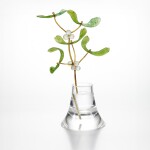
Property from the Brooklyn Museum, sold to Support Museum Collections
A RARE FABERGÉ GOLD-MOUNTED MOONSTONE, NEPHRITE AND ROCK CRYSTAL STUDY OF MISTLETOE, ST PETERSBURG, CIRCA 1900
Auction Closed
December 2, 11:54 AM GMT
Estimate
180,000 - 250,000 GBP
Lot Details
Description
Property from the Brooklyn Museum, sold to Support Museum Collections
A RARE FABERGÉ GOLD-MOUNTED MOONSTONE, NEPHRITE AND ROCK CRYSTAL STUDY OF MISTLETOE, ST PETERSBURG, CIRCA 1900
Formed as a sprig of mistletoe with finely textured gold stem emanating five nephrite leaves with two clusters of polished moonstone berries in an elegantly flared rock crystal vase, apparently unmarked; in a fitted wood, velvet and silk A La Vieille Russie case
height 14cm, 5 1/2in.
Helen Babbott Sanders, acquired from the above
The Brooklyn Museum, New York, bequest from the above in 1983
New York, A La Vieille Russie, Inc., The Art of the Goldsmith and Jeweler, 1968
New York, A La Vielle Russie, Inc., Fabergé, April 20 - June 4, 1983
New York, A La Vieille Russie, Inc., Fabergé: Exhibition for the Benefit of the Scholarship Fund of the Cooper-Hewitt Museum, the Smithsonian Institution's National Museum of Design, April 22 - May 21, 1983
Munich, Kunsthalle der Hypokulturstiftung, Fabergé: Hofjuwelier der Zaren, December 5, 1986 - February 22, 1987
Houston, Museum of Natural Science, The World of Fabergé: Russian Gems and Jewels, February 11, 1994 - July 10, 1994
San Francisco, M.H. de Young Memorial Museum, Fabergé in America: the Legacy of the Tsars, May 25 - July 28, 1996; also travelled to New York, Metropolitan Museum of Art, February 12 - April 30, 1996; Richmond, Virginia Museum of Fine Arts, August 24 - November 9, 1996; New Orleans, Fine Arts Museum, December 7, 1996 - February 8, 1997; and Cleveland Museum of Art, March 12 - May 11, 1997
Stockholm, Statens Konstmuseer, Carl Fabergé: Goldsmith to the Tsar, June 5 - October 19, 1997
New York, Brooklyn Museum of Art, BMA Fabergé Installation, supplementary to Jewels of the Romanovs: Treasures of the Russian Imperial Court, March 20 - July 12, 1998
New York, Brooklyn Museum of Art, Key to the City, June 2 - September 6, 2010
Exhibition catalogue The Art of the Goldsmith and Jeweler, New York, A La Vieille Russie, Inc., 1968, n. 337, p. 126 listed, p. 127 illustrated
Exhibition catalogue Fabergé: Exhibition for the Benefit of the Scholarship Fund of the Cooper-Hewitt Museum, the Smithsonian Institution's National Museum of Design, A La Vieille Russie, Inc., New York, 1983, n. 460, p. 125 listed, p. 126 illustrated
G. von Habsburg, Fabergé - Hofjuwelier der Zaren, Kunsthalle der Hypo-Kulturstiftung, Munich, 1986, n. 391, p. 214 illustrated
Exhibition catalogue Fabergé in America, San Francisco, 1996, n. 185, p. 200 illustrated
Exhibition catalogue Carl Fabergé: Goldsmith to the Tsar, Arlöv, 1997, no. 18, p. 94 illustrated
A. Von Solodkoff, Fabergé, London, 1998, pp. 64-65 illustrated
M. Swezey, Fabergé Flowers, New York, 2004, p. 14 illustrated
Employing a range of artists across Fabergé’s workshop, from stonecutters to gem-setters, flowers such as the present mistletoe are a lasting testimony to the diversity and ingenuity of the firm and its thoughtful use of precious materials. The present model is apparently the only known extant study of mistletoe, though others are listed, notably a mistletoe in lapis vase purchased by Mrs Leeds. Mistletoe is a rare and exotic plant in Russia, making this particular study even more uncommon.
The process of making these flowers, from the cutting of the vase in rock crystal to the setting of perfectly polished moonstone to create the berries, was a lengthy and thoughtful one. The way in which the berries of the present study hold pearlescent light when viewed from all angles is perfectly balanced by the movement in the carving of its nephrite leaves. The polish and the finely engraved details of these leaves was characteristic of Fabergé’s workshops. Nephrite, with its natural variations in colour was sourced and chosen from massive boulders near Lake Baikal in Siberia and the Sayan Highlands in the Altai Mountains.
Once all the intricate elements of flower studies had been carved, they were assembled in the workshop of Fabergé’s head workmaster Henrik Wigström. The leaves and berries were attached to a naturalistic gold stem using the most delicate pins or by setting them in discrete pockets with a special glue. The stem itself was made to resemble its natural inspiration by using an alloy of gold and copper or silver to give it a reddish or greenish hue, respectively. The gold of the stem was then textured using engraving and embossing tools by the most accurate of craftsmen in the workshop (M. Pfeifer Swezey et. al., Fabergé Flowers, New York, 2004, pp. 71-72).
As this model of mistletoe reflects, simpler, more modern flowers were often favoured by Fabergé’s clientele to elaborate blooms. The present study is an elegant and very chic representation of a mistletoe, fully conceived in three dimensions, captivating from all sides.
